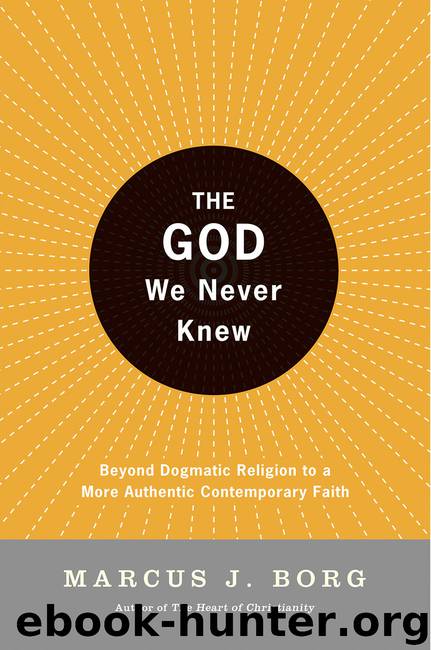The God We Never Knew by Marcus J. Borg

Author:Marcus J. Borg
Language: eng
Format: epub
Publisher: HarperCollins
METAPHORICAL AND CONCEPTUAL DEVELOPMENT
The Easter experience (with its twofold conviction that Jesus lives and is Lord) led to a transformed perception of Jesus among his followers. It generated a process of metaphorical and conceptual development that led to “the canonical Jesus” (the Jesus of the New Testament) and “the creedal Jesus” (the developed Christian doctrinal formulation of the fourth century).
During the hundred years after Jesus’ death in which the traditions now found in the New Testament took shape, Christian communities used a large number of metaphors or images (mostly drawn from the Hebrew Bible) to speak about Jesus and his significance. Jesus was the servant of God, lamb of God, light of the world, bread of life, lord, door, vine, shepherd, messiah, savior, great high priest, sacrifice, Son of God, Wisdom of God, and Word of God. Over time, these metaphors became the subject of intellectual reflection and conceptualization. Some of this, ultimately, became doctrine. This whole process—from experience through metaphor to concepts and doctrine—is what I mean by “metaphorical and conceptual development.” The process produced the post-Easter Jesus of Christian tradition.
To illustrate this process, I will summarize what I have written about elsewhere: two of the most important metaphors that emerged within the community for speaking about Jesus’ relationship to God were Jesus as the Wisdom (or Sophia) of God and Jesus as the Son of God.43 The use of Wisdom/Sophia imagery to speak of Jesus is widespread in earliest Christianity. It may have been the movement’s earliest Christology (that is, its earliest way of talking about Jesus’ relationship to God).44 Central to Paul and John, it is also found in the synoptics. Jesus is spoken of as the child, prophet, and incarnation of divine Wisdom/Sophia. Moreover, because Wisdom/Sophia was with God from the beginning, the connection to Jesus leads to the claim that what was present in Jesus was coeternal with God. The language is incarnational.
Even more important in subsequent Christian history has been the metaphor of Jesus as the Son of God. Tracing its development is illuminating. In the Jewish tradition, “son of God” could refer to Israel, the king, angels, or Jewish Spirit persons.45 It was a relational metaphor, pointing to an intimate relationship with God, like that of beloved child to parent. This seems its initial meaning as applied to Jesus: an affirmation that Jesus stood in an intimate relationship with God. Then it became a biological metaphor in the birth stories: God as the father of Jesus meant that Jesus did not have a human father but was conceived by the Spirit. Ultimately, it became a metaphysical or ontological claim: Jesus as the only begotten Son of God is of one substance with God. Something like this seems to have been the process by which the early community moved from the Easter experience through metaphor to fully developed post-Easter claims about Jesus as the preexistent Wisdom/Sophia of God and coeternal Son of God.
The Post-Easter Jesus: The Canonical Jesus This process of development can also be seen by looking at the canonical Jesus and the creedal Jesus.
Download
This site does not store any files on its server. We only index and link to content provided by other sites. Please contact the content providers to delete copyright contents if any and email us, we'll remove relevant links or contents immediately.
The Lost Art of Listening by Michael P. Nichols(7408)
Why I Am Not A Calvinist by Dr. Peter S. Ruckman(4100)
The Rosicrucians by Christopher McIntosh(3466)
Wicca: a guide for the solitary practitioner by Scott Cunningham(3127)
Signature in the Cell: DNA and the Evidence for Intelligent Design by Stephen C. Meyer(3071)
Real Sex by Lauren F. Winner(2967)
The Holy Spirit by Billy Graham(2893)
To Light a Sacred Flame by Silver RavenWolf(2768)
The End of Faith by Sam Harris(2690)
The Gnostic Gospels by Pagels Elaine(2472)
Waking Up by Sam Harris(2392)
Nine Parts of Desire by Geraldine Brooks(2326)
Jesus by Paul Johnson(2310)
Devil, The by Almond Philip C(2282)
The God delusion by Richard Dawkins(2265)
Heavens on Earth by Michael Shermer(2237)
Kundalini by Gopi Krishna(2137)
Chosen by God by R. C. Sproul(2123)
The Nature of Consciousness by Rupert Spira(2047)
